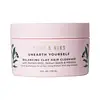What's inside
What's inside
 Key Ingredients
Key Ingredients

 Benefits
Benefits

 Concerns
Concerns

 Ingredients Side-by-side
Ingredients Side-by-side

Water
Skin ConditioningGlycerin
HumectantOryza Sativa Seed Water
AntimicrobialAloe Barbadensis Leaf Juice
Skin ConditioningCamellia Sinensis Seed Extract
HumectantPanthenol
Skin ConditioningOryza Sativa Powder
Sapindus Mukorossi Fruit Powder
Polyquaternium-7
Camellia Sinensis Leaf
PerfumingCocos Nucifera Oil
MaskingCannabis Sativa Seed Oil
EmollientPrunus Armeniaca Kernel Oil
MaskingParfum
MaskingDecyl Glucoside
CleansingCaprylyl Glycol
EmollientGlycolic Acid
BufferingSoybean Peroxidase
AntioxidantLeuconostoc Ferment Filtrate
AntimicrobialPhenoxyethanol
PreservativeSuperoxide Dismutase
AntioxidantWater, Glycerin, Oryza Sativa Seed Water, Aloe Barbadensis Leaf Juice, Camellia Sinensis Seed Extract, Panthenol, Oryza Sativa Powder, Sapindus Mukorossi Fruit Powder, Polyquaternium-7, Camellia Sinensis Leaf, Cocos Nucifera Oil, Cannabis Sativa Seed Oil, Prunus Armeniaca Kernel Oil, Parfum, Decyl Glucoside, Caprylyl Glycol, Glycolic Acid, Soybean Peroxidase, Leuconostoc Ferment Filtrate, Phenoxyethanol, Superoxide Dismutase
Glycerin
HumectantSodium Cocoyl Isethionate
CleansingKaolin
AbrasiveCoconut Acid
CleansingVaccinium Corymbosum Seed
AbrasiveCetearyl Alcohol
EmollientPolylactic Acid
AbrasiveSodium Isethionate
CleansingCocos Nucifera Oil
MaskingBentonite
AbsorbentBehentrimonium Methosulfate
Tapioca Starch
Moringa Oleifera Seed Oil
EmollientSimmondsia Chinensis Seed Oil
EmollientArnica Montana Flower Extract
MaskingEclipta Prostrata Leaf Extract
Skin ConditioningHibiscus Esculentus Fruit Extract
Skin ConditioningPhyllanthus Emblica Fruit Extract
HumectantParfum
MaskingPhenoxyethanol
PreservativeCaprylyl Glycol
EmollientGlycerin, Sodium Cocoyl Isethionate, Kaolin, Coconut Acid, Vaccinium Corymbosum Seed, Cetearyl Alcohol, Polylactic Acid, Sodium Isethionate, Cocos Nucifera Oil, Bentonite, Behentrimonium Methosulfate, Tapioca Starch, Moringa Oleifera Seed Oil, Simmondsia Chinensis Seed Oil, Arnica Montana Flower Extract, Eclipta Prostrata Leaf Extract, Hibiscus Esculentus Fruit Extract, Phyllanthus Emblica Fruit Extract, Parfum, Phenoxyethanol, Caprylyl Glycol
Ingredients Explained
These ingredients are found in both products.
Ingredients higher up in an ingredient list are typically present in a larger amount.
Caprylyl Glycol is a humectant and emollient, meaning it attracts and preserves moisture.
It is a common ingredient in many products, especially those designed to hydrate skin. The primary benefits are retaining moisture, skin softening, and promoting a healthy skin barrier.
Though Caprylyl Glycol is an alcohol derived from fatty acids, it is not the kind that can dry out skin.
This ingredient is also used as a preservative to extend the life of products. It has slight antimicrobial properties.
Learn more about Caprylyl GlycolCocos Nucifera Oil is obtained from the kernels of the coconut fruit. In other words, this is coconut oil.
Coconut Oil is rich in fatty acids with lauric acid making up the majority of these. It also contains linoleic acid. Due to this high fatty acid content, coconut oil helps trap moisture and soften skin.
Despite being antibacterial, coconut oil may not be great for acne-prone skin. It is comedogenic and may clog pores. This ingredient may not be safe for malassezia or fungal acne.
Note: Coconut Oil should not replace your sunscreen for UV protection. Studies show it only blocks about 20% of UV.
This oil is non-volatile and has a light scent.
The term 'fragrance' is not regulated in many countries. In many cases, it is up to the brand to define this term. For instance, many brands choose to label themselves as "fragrance-free" because they are not using synthetic fragrances. However, their products may still contain ingredients such as essential oils that are considered a fragrance.
Learn more about Cocos Nucifera OilGlycerin is already naturally found in your skin. It helps moisturize and protect your skin.
A study from 2016 found glycerin to be more effective as a humectant than AHAs and hyaluronic acid.
As a humectant, it helps the skin stay hydrated by pulling moisture to your skin. The low molecular weight of glycerin allows it to pull moisture into the deeper layers of your skin.
Hydrated skin improves your skin barrier; Your skin barrier helps protect against irritants and bacteria.
Glycerin has also been found to have antimicrobial and antiviral properties. Due to these properties, glycerin is often used in wound and burn treatments.
In cosmetics, glycerin is usually derived from plants such as soybean or palm. However, it can also be sourced from animals, such as tallow or animal fat.
This ingredient is organic, colorless, odorless, and non-toxic.
Glycerin is the name for this ingredient in American English. British English uses Glycerol/Glycerine.
Learn more about GlycerinParfum is a catch-all term for an ingredient or more that is used to give a scent to products.
Also called "fragrance", this ingredient can be a blend of hundreds of chemicals or plant oils. This means every product with "fragrance" or "parfum" in the ingredients list is a different mixture.
For instance, Habanolide is a proprietary trade name for a specific aroma chemical. When used as a fragrance ingredient in cosmetics, most aroma chemicals fall under the broad labeling category of “FRAGRANCE” or “PARFUM” according to EU and US regulations.
The term 'parfum' or 'fragrance' is not regulated in many countries. In many cases, it is up to the brand to define this term.
For instance, many brands choose to label themselves as "fragrance-free" because they are not using synthetic fragrances. However, their products may still contain ingredients such as essential oils that are considered a fragrance by INCI standards.
One example is Calendula flower extract. Calendula is an essential oil that still imparts a scent or 'fragrance'.
Depending on the blend, the ingredients in the mixture can cause allergies and sensitivities on the skin. Some ingredients that are known EU allergens include linalool and citronellol.
Parfum can also be used to mask or cover an unpleasant scent.
The bottom line is: not all fragrances/parfum/ingredients are created equally. If you are worried about fragrances, we recommend taking a closer look at an ingredient. And of course, we always recommend speaking with a professional.
Learn more about ParfumPhenoxyethanol is a preservative that has germicide, antimicrobial, and aromatic properties. Studies show that phenoxyethanol can prevent microbial growth. By itself, it has a scent that is similar to that of a rose.
It's often used in formulations along with Caprylyl Glycol to preserve the shelf life of products.